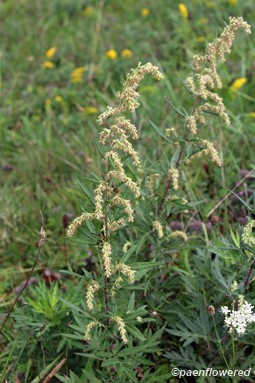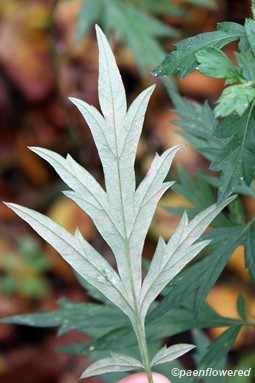Artemisia vulgaris
A European herb known for its medicinal properties
Artemisia vulgaris common mugwort
This perennial alien fast-spreading weed is a member of the aster family and a member of a genus that includes the wormwoods and the mugworts. It is easily overlooked because the numerous composite flowers are whitish-green turning to dull red in the center. The mature flowers look like they are ready to open further, but never do. They are wind pollinated. The elongated flower stalks (panicles) are normally erect but may bend over from weight when mature. Individual flower heads are only 1/8 to ¼ inch long and consist of only disk florets.
The plant itself can be quite large 2-4 feet high. The lower leaves are deeply cut and silvery downy beneath and resemble those of chrysanthemums. The upper leaves are lance-shaped. The leaves of the plant are aromatic. The stems may have a red-purplish tint.
It is found growing in various types of waste ground, roadsides and fields in southeastern Canada, eastern United States and in scattered populations in the west. It blooms from July to October. This temperate Eurasian plant is difficult to eradicate. Even if cut back, it can grow again from stout, horizontal rhizome below the surface. To eliminate the plant, these must be pulled or dug up.
Although the leaves are somewhat bitter they are edible, large quantities may cause poisoning. In some countries the plant is used either for flavoring or coloring food. It has had long use as medicinal herb but is dangerous for pregnant women because it may cause miscarriage.
Habitat & Range
Grows in lawns, gardens, along roadsides, and in other man-disturbed habitats.
Present throughout the state.
| EMP: | UPL |
|---|---|
| NCNE: | UPL |
Phenology
Flowers June to October.







Comments
Have you spotted this plant in your area? We'd love to hear about your experience! Share your comments or questions about the plant below. Comments are moderated before posting.